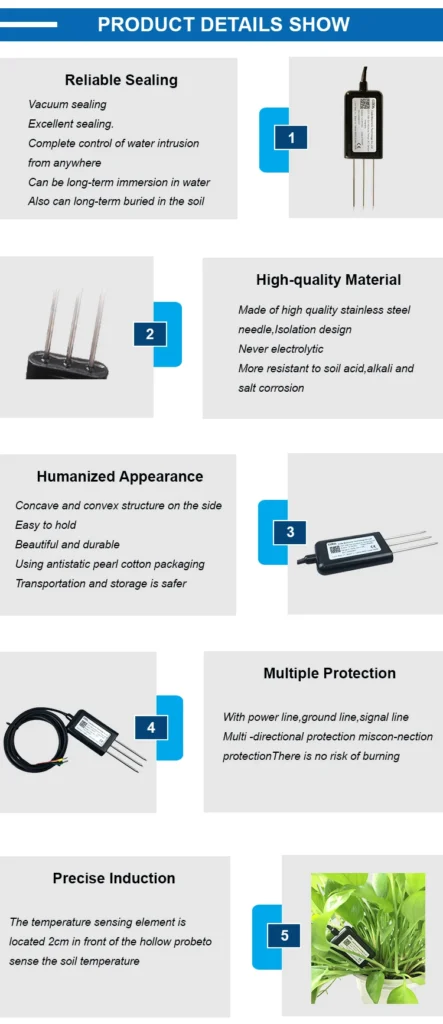What is a Soil Moisture Sensor?
Introduction
What is a Soil Moisture Sensor? Soil moisture sensors are important tools used in farming, environmental monitoring, and soil research. This article explains what soil moisture sensors are, how they work, and their practical uses. This will help readers understand this important technology better.
1. Definition of a Soil Moisture Sensor
A soil moisture sensor measures how much moisture is in the soil. It detects changes in soil moisture levels. Then, it turns this data into electrical signals that can be read and analyzed.
These sensors are important for checking soil conditions. They help plants grow better and improve water management.
2. Working Principles of Soil Moisture Sensors
Soil moisture sensors use different technologies. Two main methods are Time Domain Reflectometry (TDR) and Frequency Domain Reflectometry (FDR).
**TDR Working Principle:**
TDR sensors send high-frequency electromagnetic pulses through metal wires in the soil. When these pulses hit boundaries, like air and soil, they bounce back. The soil’s dielectric constant is closely linked to its moisture level. This means the speed and reflection time of the pulses change with the amount of moisture in the soil.
By measuring the time difference of these reflections, we can find the soil’s dielectric constant. This helps us understand how much water is in the soil.
TDR sensors are very accurate. Soil type or density does not affect their performance. This makes them great for precise measurements. However, they are more expensive and harder to install than other sensors.
**FDR Working Principle:**
FDR sensors detect changes in how electromagnetic waves respond when they meet the soil. These sensors send out signals at a certain frequency. They then measure changes in the resonant frequency as the soil’s moisture levels change.
More soil moisture raises the dielectric constant, which alters the resonant frequency. By observing these frequency changes, the sensor can measure soil moisture indirectly. FDR sensors are cheap, give quick measurements, and have flexible probe designs for different depths. This makes them great for situations needing fast data collection and low costs.
3. Applications of Soil Moisture Sensors
– **Agricultural Production:**
In farming, these sensors check soil moisture levels. They help improve irrigation schedules. This saves water and supports healthy crop growth.
– **Environmental Monitoring:**
By measuring the time difference of these reflections, we can find the soil’s dielectric constant. This helps us know its water content. TDR sensors are very accurate, and they are not affected by soil type or density.
These sensors give real-time data on soil moisture for environmental reasons. This data helps us check soil quality, predict natural disasters, and study climate change effects.
– **Soil Research:**
Soil moisture sensors give precise measurements in research and science. They help scientists learn about soil properties, find issues like soil diseases, and evaluate environmental conditions.
4. Future Development Directions
With rapid advancements in science and technology, soil moisture sensors are becoming more accurate and reliable. Future work will likely aim to make them more sensitive, stable, and durable with new materials and methods. Teamwork across different fields will also help combine these sensors with other technologies, like remote monitoring systems. This will lead to better ways to manage the environment.
Conclusion
Soil moisture sensors are very important in many areas. They allow real-time monitoring of soil conditions. This helps with sustainable farming, disaster prevention, climate studies, and protecting the environment.
As technology gets better, these sensors will improve too. They will give helpful data to support global efforts for using resources wisely and keeping ecosystems healthy.
